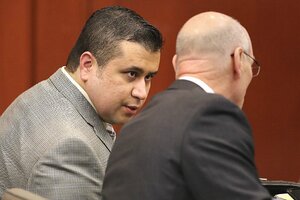Who screamed? Limits of aural forensics in Trayvon Martin case could impact George Zimmerman’s defense
In an unusual Saturday hearing, the judge is considering forensics evidence that could tie George Zimmerman – or Trayvon Martin, the teenager Zimmerman shot and killed – to cries heard on a 911 tape.

George Zimmerman talks to defense counsel Don West at Seminole circuit court, in Sanford, Fla., during a pre-trial hearing Friday. Jury selection in Zimmerman’s trial is scheduled to begin Monday.
Joe Burbank/Orlando Sentinel/AP
ATLANTA
Who did the panicked screams and pleas on a 911 tape caught the moment before George Zimmerman shot Trayvon Martin belong to? That’s the topic of an unusual Saturday hearing ahead of Monday’s long-awaited murder trial.
Circuit Court Judge Debra Nelson continued to hear testimony on Saturday about whether a bold analysis by a long-time aural forensics expert should be heard by jurors.
Retired University of Washington speech forensics expert Alan Reich testified on Friday that a set of screams and pleas to “stop” and “I’m begging you” before a shot was fired matched the voice of Trayvon, an unarmed black teenager who was shot to death on Feb. 26, 2012 while walking back to his father’s house in a gated Sanford, Fla., neighborhood.
Zimmerman’s father, retired magistrate judge Robert Zimmerman, has claimed his son is the one who screamed as Trayvon pummeled him and beat his head against the ground, causing Zimmerman to fire to save his own life. Zimmerman sustained a broken nose and a laceration on the back of his head from the fight, according to forensic photos released by the court.
To be sure, other audio forensic experts have said Mr. Reich’s findings are overreaching given that the analysis deviates from FBI standards about how to identify screams and how many seconds of audio are necessary to properly analyze the identity of voices.
Either way, Judge Nelson’s decision is going to be critical for the high-profile trial of a case that has divided America along racial and cultural lines as it touches on hot-button issues of racial stereotypes and armed self-defense in public.
Trayvon was walking from a convenience store on the night of the NBA All-Star game on Feb. 26, 2012, when he was confronted by Zimmerman, an aspiring cop who led a volunteer watch effort in a neighborhood that had been dogged by small-time crimes, many of them committed by young black men.
Though a 911 operator had told Zimmerman to stay put, he approached Trayvon, a tall teenager wearing a hoodie, with candy and a drink in his pockets. A fight ensued, and Zimmerman shot Trayvon point-blank in the chest.
Zimmerman was originally let go by Sanford police, who said that he was simply “standing his ground” under a 2005 law that negates an imperative to retreat before using deadly force in defense. But the author of that law has since said it wasn’t meant to protect those who pursued people, killed them, and then claimed self-defense.
In April, Zimmerman waived a non-jury “stand your ground” immunity hearing under the law, which could have protected him both from legal and civil prosecution.
The defense has made public a series of Twitter and Facebook messages, as well as photos, that show Trayvon’s proclivity for marijuana and getting into fights. The boy was suspended from his Miami high school and was spending time in Sanford with his father when he was killed.
Last week, Judge Nelson ruled that Trayvon’s social media texts and photos could not be used as direct testimony to the jury, agreeing with prosecutors who have maintained that Trayvon’s background is irrelevant, since the teenager would likely not have died had Zimmerman not decided to pursue him against the 911 operator’s warning.
With that as the backdrop, a series of 911 calls from neighbors have become critical to Zimmerman’s self-defense case. If Reich is allowed to share his findings with the jury, it would complicate Zimmerman’s defense.
“Was it George or not George, Trayvon or not Trayvon – we had very simple elimination decisions …,” Reich told the court Friday. “The scream levels were almost entirely those of Trayvon Martin.”
On Saturday, the defense brought their own expert, Dr. Peter French, a long time forensics expert from Britain, to testify about whether it’s possible to identify who screaming voices belong to.
On the stand Saturday, Mr. French agreed with Reich that it doesn’t matter how long a clip is in order to make it suitable for voice comparison, but ultimately surmised that the 911 calls that Reich studied are not suitable for the purpose of comparing speakers.
“There can’t be any meaningful findings” from the screams on the audio, he told Judge Nelson.

